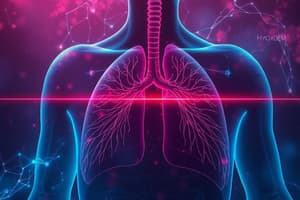Podcast
Questions and Answers
What does hypoxemia mean?
What does hypoxemia mean?
reduced oxygen levels in the blood
What does hypoxia refer to?
What does hypoxia refer to?
insufficient oxygen anywhere in the body - think tissue
What are early signs of hypoxemia?
What are early signs of hypoxemia?
tachypnea, tachycardia, restlessness, pale skin and mucous membranes, elevated BP, symptoms of respiratory distress
What are late signs of hypoxemia?
What are late signs of hypoxemia?
What are early signs of hypoxia?
What are early signs of hypoxia?
What are late signs of hypoxia?
What are late signs of hypoxia?
Flashcards are hidden until you start studying
Study Notes
Definitions
- Hypoxemia: Characterized by low oxygen levels in the bloodstream, potentially affecting overall oxygen delivery to tissues.
- Hypoxia: Refers to insufficient oxygen availability in tissues throughout the body, impacting cellular function and metabolism.
Early Signs of Hypoxemia
- Symptoms include tachypnea (increased breathing rate) and tachycardia (increased heart rate).
- May manifest as restlessness and changes in skin color, such as pale skin and mucous membranes.
- Often accompanied by elevated blood pressure and indicators of respiratory distress.
Late Signs of Hypoxemia
- Severe symptoms include confusion and stupor, reflecting impaired cognitive function due to inadequate oxygenation.
- Physical indicators include cyanotic skin and mucous membranes, signaling significant oxygen deprivation.
- Other late signs comprise bradypnea (decreased respiratory rate), bradycardia (decreased heart rate), hypotension, and potential cardiac dysrhythmias.
Early Signs of Hypoxia
- Early symptoms may involve heightened restlessness, tachycardia, and tachypnea.
- Patients might experience dyspnea (difficulty breathing) along with increased agitation and anxiety.
- Additional signs can include diaphoresis (excessive sweating), retractions during breathing, and headache.
Late Signs of Hypoxia
- Progression leads to increased restlessness and stupor, indicating severe oxygen deprivation.
- Patients may exhibit marked dyspnea and significantly decreased respirations, which require urgent attention.
- Early indicators evolve into bradycardia and cyanosis, necessitating immediate medical intervention.
Studying That Suits You
Use AI to generate personalized quizzes and flashcards to suit your learning preferences.



